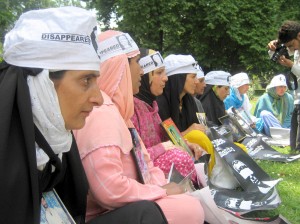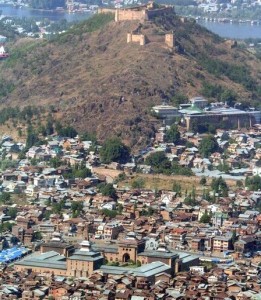Peace Watch » Perspectives » Indian Women Support Kashmir Cause?
Indian Women Support Kashmir Cause?
Will the women group take the lead?
Z.G. MUHAMMAD
Scepticism and disbelieving about anything coming from New Delhi has largely become our second nature. This trust deficit is not needless. It has a history. Sixty-five years long history, dating back to first Indian Prime Minister, Jawaharlal Nehru. Notwithstanding, my disbelief, I see a recently held one day women convention at Kashmir University by a New Delhi based senior journalist Seema Mustafa as worth noticing.
In a way, it was making a history of sorts. Eleven top Indian women activists arrived in the most salubrious and beautiful campus of Kashmir University on Tuesday to express solidarity with the women of Kashmir. The activists representing various women organization of India included Laila Pasha, Doctor Jotyshina Chattergee, TK Raja Lakshmi, Prof. Anuradha Chenoy, Ms. Zakiya, Sahiba Farooqui, Promila Lamba, Sushnai Ali and Kalpana David.
It has not been for the first time that a New Delhi based organization has succeeded in bringing a contingent of women activists from various to Kashmir University or to the city of Srinagar. For past couple of years the activities of some New Delhi based institutions and nongovernmental organizations in Kashmir University and other campuses in the state has increased many fold. These institutions have not only been able to co-opt in the support of some retired women college principals, teachers, and elite women activists but have also been engaging some academics in their projects. These organizations and institution have also been holding seminars and conferences at Srinagar and other places in India from New Delhi’s perspective. Some have extended their areas of activities across the LOC and established nucleus bodies in Muzzafarabad as well.
Once bitten twice shy! True, to this adage, a women’s group headed by Anjum Zamrud Habib, doubted the intentions the Centre for Policy Analysis for holding convention in the University. In her thousand-word statement, she raised some important points about the motives behind organizing such conventions by CPA and other such groups in the Kashmir University. Seeing the one day convention as a “damage control exercise for India” she saw its main objective as “delinking (thus depoliticizing) of the issue of women’s rights in Kashmir from larger question of Kashmir and therefore further breaking the back of women’s resistance and demand for Azadi.” Some students during their interventions at the Convention vociferously articulated similar fears about such seminars and conventions and saw these as attempting at creating alternative discourses and weakening the people’s narrative. In fact, the doubts raised are a manifestation of the mistrust that has struck its deep roots during past many decades and has become a cardinal belief with larger sections of the society.
This mistrust in activists and intellectuals has a history. At the peak of the popularity of the progressive movement, Jawaharlal Nehru pushed some top left leaning writers into Kashmir to shape and strengthen the ‘dominant discourse’. Many of them saw Kashmir as “laboratory for testing” their ideology. Even after 1955, Nehru utilized the services of eminent writers and journalists like K.A. Abbas and R.K. Kranji for winning over the Plebiscite Front leaders including Sheikh Muhammad Abdullah. Since 1990, there has been hardly any top name in Indian academics and journalism or think tank that was not sent to Kashmir. Most of these intellectuals and activists instead of looking at the situation in its historical context ‘experimented with a variety of metaphors’ to grapple with the situation that failed to bring out any tangible results.
For the presentation made by some women activists and the unanimous resolution adopted at the end of the conference the Tuesday Women’s convention caught my imagination. It seemed departure from other such conferences so as the resolution is concerned. It demanded demilitarization of the state, repealing of the laws like the Armed Forces Special Powers Act, the Public Safety Act and other such laws. It called for immediate punishment to security personnel and all others accused of rape and molestation, rehabilitation of widows and half widows, compilation of detailed records of missing persons, employment schemes and opportunities for the widows and half widows, establishment of a commission and resettlement of Kashmiri Pandits.
Seen in right perspective, the resolution adopted at the women’s convention largely seems affirmation of some conditions laid down by the Hurriyat Conference for initiation of a dialogue with New Delhi. In as much demanding demilitarization, which is not synonymous with redeployment the resolution also articulates the demand often made by Syed Ali Geelani’s faction of Hurriyat.
The convention also sounded different from other such meets for its refrain: “the people of the state need to draw a distinction between the Indian State and People of India.” Sounding different, almost every women speaker made this assertion. Perhaps, it has been for the first time when an important section of Indian civil society asked people of the state for drawing a distinction between the two. It reminded of the split in thinking between the American State and the People of US in general and intelligentsia in particular during the Vietnam War. For many in America Vietnam was ‘antithesis of the promise of American life.’ President Lyndon Johnsons image ‘despite good record in the area of civil rights suffered and alienated many of his supporters. David Levine’s cartoon and Noam Chomsky’s writing made a big difference to the American thinking of Vietnam. The honest report by journalist Walter Cronkite from Saigon with famous line, “”we cannot win this goddamned war, and we ought to find a dignified way out”, changed the Lyndon Johnson thinking. The American writers with Robert Bly and David Ray in lead launched a sustained and proactive campaign against American policies in Vietnam.
The question that stared at face on many who attended the convention is if Seema Mustafa and other women activists will assume the role of Jane Fonda, Susan Sontag or Robert Bly. It is not to suggest that no voices in support of Kashmir were raised in New Delhi. During three, consecutive summers of discontent many important voices from important writers, academia, professional and media men from Arundhati Roy to Swaminathan S Anklesaria Aiyar strongly sided with the people of Jammu and Kashmir but so far there has not been any organized pro Kashmir People movement like the one led by poet Robert Bly in USA in New Delhi. Will the women group take the lead?
Filed under: Perspectives







